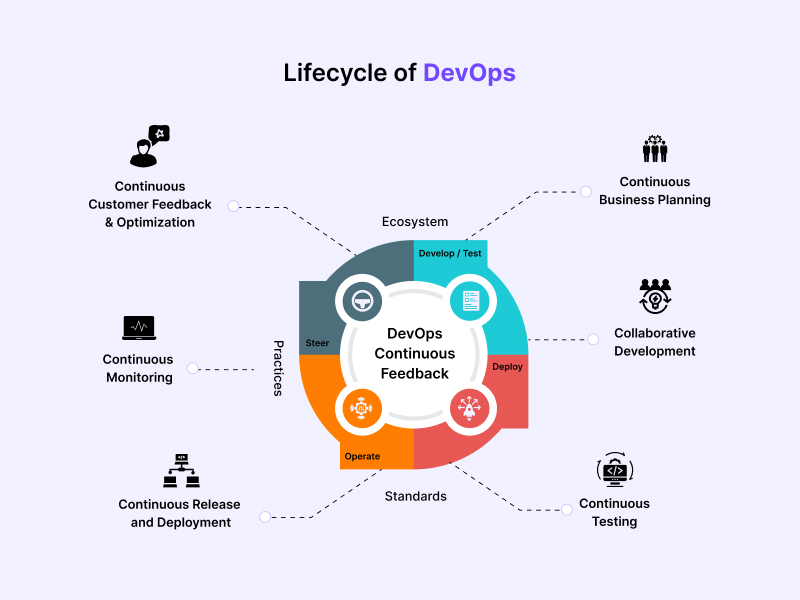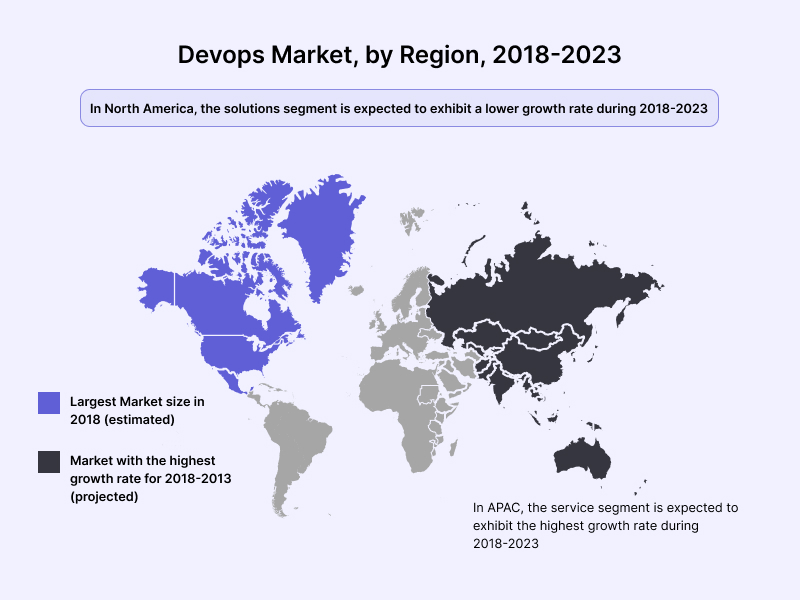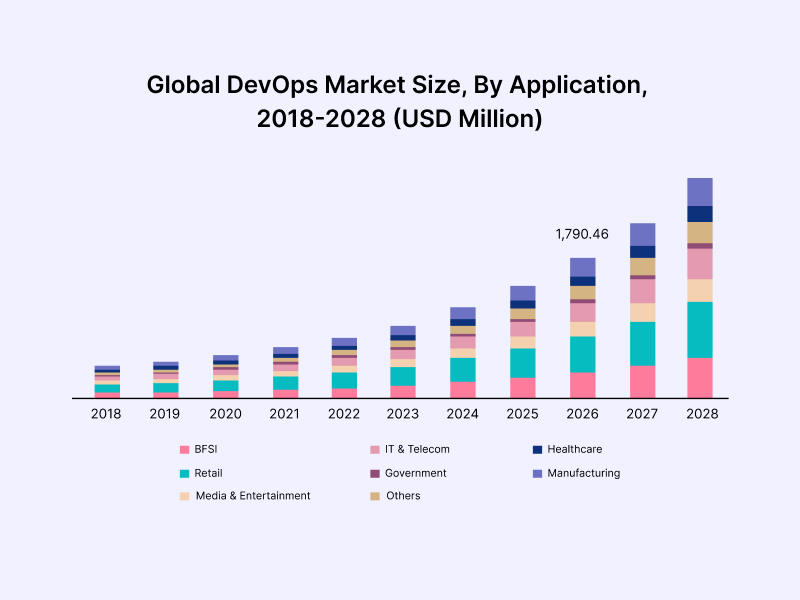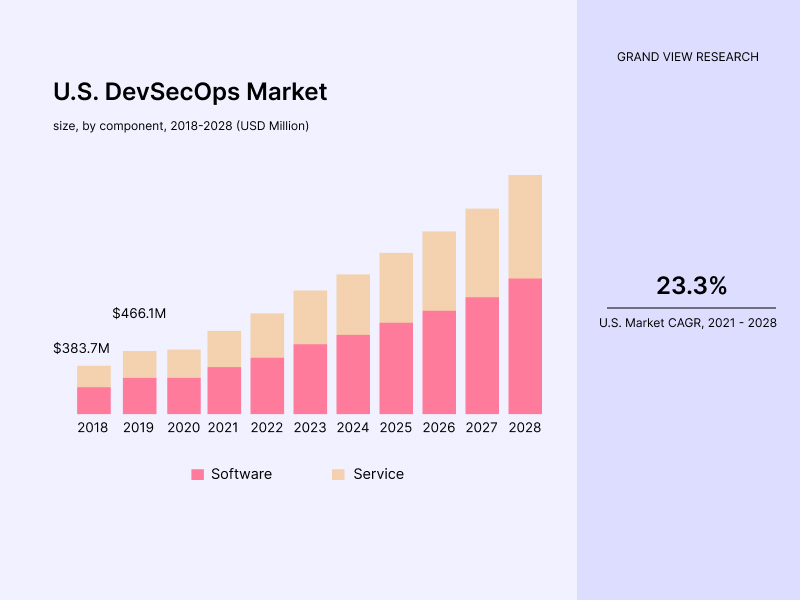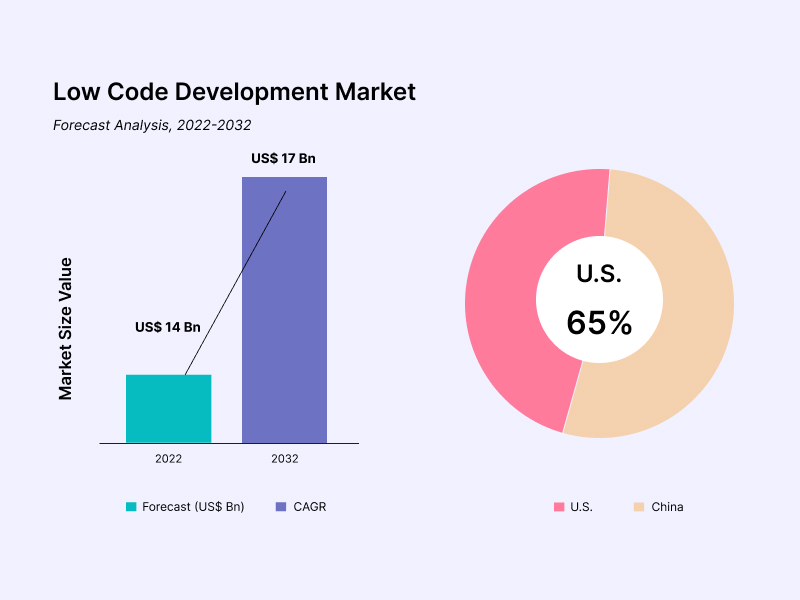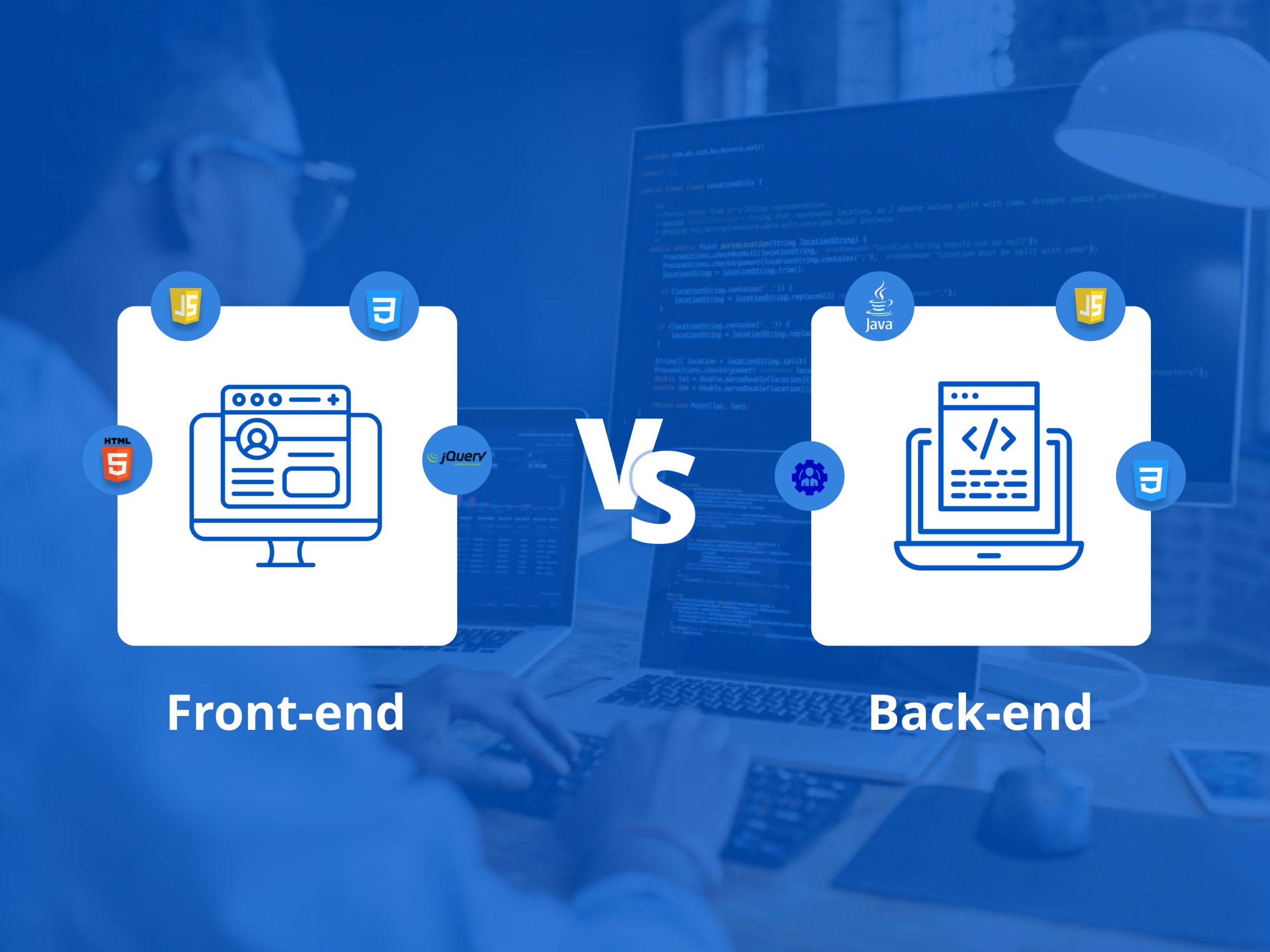Do you know why DevOps is the most talked about technology trend? It’s because of its ability to help businesses increase productivity, decrease downtime, and improve collaboration. And with that comes an array of DevOps Trends arriving in 2024.
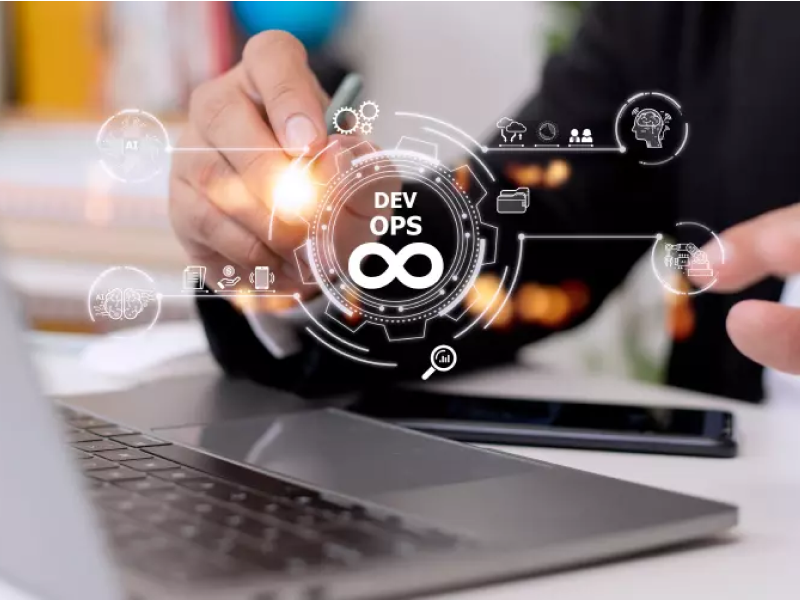
From containers to automation pipelines, DevOps will continue to evolve and be used across many industries. This guide will give you a better understanding of what is changing in the world of DevOps in 2024 and how it can benefit your business if implemented correctly.
Before digging deep, it’s essential to learn more about DevOps and its market scenario. So, grab a cup of coffee, and let’s get started!
Also Read: DevSecOps vs. DevOps: Which Approach is Better?
Table of Contents
What is DevOps?
DevOps is a set of practices that combines software development (Dev) and information-technology operations (Ops) to shorten the systems development life cycle while delivering features, fixes, and updates frequently in close alignment with business objectives.
It helps to reduce complexity and improve collaboration by creating a cross-functional team that includes members from various areas, such as developers, system administrators, quality assurance teams, security professionals, and product owners.
DevOps aims to streamline the process of developing applications so they can be released quickly without compromising on quality or service delivery. This allows organizations to respond faster to customer demands while saving time and money on resource allocation.
Statistics Showing DevOps Popularity
Undoubtedly, the market is enormous; it’s still developing because DevOps has its unique impact on the software industry. Here are a few more DevOps adoption statistics you might be interested in:
- The global DevOps market will grow at a CAGR of 24.59% by 2027, arriving at over 22199.4M USD.
- The large organizations’ component in Brazil’s DevOps market will attain a CAGR of about 20% by 2028.
- Asia-Pacific’s DevOps market will experience a tremendous boost of around 25% by 2028.
- A report by Global Market Insights displays that DevOps Market will be worth over $30 Bn by 2028.
Top 11 DevOps Trends in 2024 You Must Know
“DevOps adoption means that you are willing to change fast, develop fast, test fast, fail fast, recover fast, learn fast and push the product/features fast to the market.” – Pavan Belagatti.
As DevOps continues to evolve and become more popular, it is essential to stay abreast of the latest trends that can help organizations maximize their use of this technology. Here are some upcoming trends in DevOps you should look out for over the next few years:
The Rise of Automation
Automation will increasingly be used in DevOps to speed up processes and minimize errors caused by manual intervention. Tools such as Ansible and Chef have already been instrumental in automating various tasks within an organization’s IT infrastructure.
Also Read: Automation in Software Development- A New Stream of Revolution
AI/ML Integration In CI/CD Pipelines
Artificial intelligence (AI) and machine learning (ML) technologies are now used in pipelines to adapt better to quickly changing development needs while improving accuracy levels at every step. This trend will only continue to grow as teams seek new ways to optimize their operations through streamlined automation processes powered by AI/ML.
Cloud Native Platforms
The rise of serverless computing and the increased demand for faster and more resilient software delivery pipelines has made cloud-native platforms a must-have for DevOps teams.
These solutions offer improved scalability, cost savings benefits, and automated operations to help streamline development workflows. We expect this trend to continue to gain momentum in 2024 as organizations look for further improvements in their infrastructure capabilities while meeting customer demands with high-quality products at rapid speed.
Also Read: DevOps in Mobile App Development: Is it Worth the Hype?
DevSecOps/Secure Software Development Lifecycle (SSDL)
Security is becoming increasingly important in the software development lifecycle. With this growing need for secure coding practices and toolsets comes the emergence of DevSecOps and Secure Software Development Lifecycles (SSDL).
This trend looks to become more prevalent over the coming years as companies strive towards creating codebases that are safe from malicious outsiders and internal threats like human error or insider attacks.
Containers Everywhere
Containerization is one of the most popular trends in DevOps, and it looks like this won’t change anytime soon. By 2024, we expect to see even more companies transitioning to containerized deployments for their applications.
Containers allow developers to deploy applications quickly without worrying about the underlying infrastructure or environment. With the help of orchestration tools such as Kubernetes, teams can quickly scale up and down with high availability while ensuring optimal performance across all environments.
Integrated Toolchains & Automation Platforms
As organizations become increasingly aware of how powerful automation is for accelerating development cycles, they are turning towards integrated toolchains that provide a single platform for managing code pipelines, running automated tests, and deploying changes across multiple environments simultaneously.
Companies are also beginning to shift away from manual scripting solutions and instead opting for comprehensive automation platforms that enable them to automate virtually every aspect of their software delivery process. This will undoubtedly continue into 2024, providing further opportunities for those looking to take advantage of these new technologies.
Chaos Engineering
Chaos engineering intentionally introduces disruptions into production systems to test their resilience and identify weaknesses. Rather than relying on traditional testing practices, which are often limited in scope, chaos engineering attempts to simulate real-world events such as hardware failure or network latency.
This helps engineers understand how the system responds in different scenarios, allowing them to make more informed decisions about future changes and improvements. With its reliance on automation, chaos engineering will become increasingly popular for DevOps teams looking to improve their systems’ reliability in 2024.
Kubernetes
Kubernetes is an open-source container orchestration system that allows users to manage and scale applications easily. Initially developed by Google, Kubernetes has quickly become the de facto standard for running distributed applications in production.
It provides powerful features such as automatic resource allocation, scheduling of workloads, and self-healing capabilities that make it easier for developers to maintain their applications.
Additionally, Kubernetes supports a wide variety of languages and frameworks, which makes it possible to integrate existing applications into the platform. As more companies look towards cloud computing solutions like Kubernetes, their popularity will only grow in 2024.
Low-Code Development
Low-code development (LCD) is rapidly becoming a popular way for software developers to quickly and easily build applications. Low code enables developers to develop applications with minimal coding knowledge regardless of technical prowess.
This form of development allows teams to create complex user interfaces without having to write complicated code or spend large amounts of time on debugging. LCD also reduces the number of lines of code needed, allowing developers more flexibility when creating their application architectures.
Microservices Architecture
Microservices architecture is software engineering that decomposes applications into independent and modular services. Each service performs a specific task in the application, making it easier for developers to work on separate components without interfering with any other part of the system.
The microservices architecture also makes it easier to scale applications and update parts as needed without impacting other pieces. This approach has become popular among DevOps teams because it allows them to deploy updates while keeping systems highly available and reliable quickly.
Observability
Observability is the ability to monitor and manage a system, service, or application without having direct access to the code. It is typically done with advanced analytics tools that provide real-time insights into how an application functions.
Observability helps DevOps teams identify issues quickly and make necessary changes to ensure applications run smoothly. This trend will continue to grow as more organizations use microservices architectures composed of many different components working together in complex ways.
5 Common DevOps Myths Among Businesses
“Currently, DevOps is more like a philosophical movement, not yet a precise collection of practices, descriptive or prescriptive.”—Gene Kim.
Businesses often need help understanding the true scope and value of DevOps, which can lead to several misconceptions that can hinder successful implementations. Here are five of the most common DevOps myths among businesses:
Myth 1: DevOps is Expensive
One of the biggest misconceptions about DevOps is that it’s expensive. In reality, investing in DevOps can help businesses save money by reducing operational costs and increasing efficiency.
Myth 2: It Requires a Complete Overhaul of Existing Processes
Businesses don’t need to revamp their processes to employ successful DevOps practices. Instead, they should focus on using the right tools and making incremental improvements.
Myth 3: It Needs Too Many Resources
Many companies believe that implementing a successful DevOps strategy requires limited resources, such as personnel and capital investments. While some upfront costs are necessary for setting up a good environment, the long-term benefits outweigh them.
Myth 4: Automation Replaces Manual Labor
Despite its name implying otherwise, automation does not replace but complements manual labor when deploying new applications or running tests quickly without error. The real value lies in leveraging automated and manual steps within the same process instead of going all one way or another.
Myth 5: You Have To Be Tech-savvy
Companies often assume that only highly technical employees can effectively work with DevOps tools and processes. However, this misconception overlooks that many tasks associated with DevOps are relatively straightforward. Those without extensive technical backgrounds can gain a basic understanding of DevOps operations and add value to their organizations.
Key Benefits of Implementing DevOps Trends
“Agile and DevOps are for harnessing integration, interaction, and innovation.” ― Pearl Zhu.
Here are some key benefits of implementing a DevOps strategy:
Increased Speed and Agility
DevOps enables organizations to deploy new features, products, and services at scale quickly. By automating the build, test, and release process, development teams can deliver value faster to their customers.
Improved Collaboration
With DevOps, silos between teams 1are broken down, making it easier for them to collaborate effectively across any project or initiative they’re working on.
This helps improve cross-team communication, productivity, and efficiency while reducing the risk of errors caused by miscommunication or lack of coordination among different departments within an organization.
Enhanced Security
Automated processes enable security patching promptly, reducing the risk of vulnerabilities being exploited in production environments due to outdated software or configurations not being patched in time.
DevOps also provides continuous monitoring capabilities that allow incident response teams to identify potential threats quickly. It gives them enough time for effective mitigation strategies before severe damage can occur from malicious actors targeting your system infrastructure.
Reduced Costs
Automated deployments do not need manual labor costs associated with manual deployments, thus reducing the total cost of ownership (TCO). Additionally, cloud computing platforms such as Amazon Web Services minimize hardware costs.
Increased Efficiency
Automated deployments reduce the time required to deploy a new feature or fix a bug, allowing for greater agility and faster customer response times. Furthermore, with continuous integration (CI) and continuous delivery (CD), teams can test their code more frequently, leading to quicker bug fixes and possible implementation of new features in shorter periods.
Growth Opportunities
DevOps enables businesses to take advantage of cloud computing technologies, allowing them to scale up operations quickly without incurring costs associated with buying additional hardware or software licenses. This is especially if their product needs sudden bursts of increased capacity due to unexpected spikes in traffic or usage patterns.
Conclusion
DevOps is quickly becoming the norm in today’s tech industry. With its continuous delivery and shared responsibility model, DevOps has enabled businesses to swiftly deploy new applications and updates with minimal impact on user experience.
This article has compiled a list of DevOps trends that will likely continue into the next year. By reading through this guide, you will better understand what these changes mean for your business and how you can make the most of them. So if you want to take your DevOps approach up a notch in 2024, check out our list!
Also, hire top-notch DevOps service providers to ensure your organization can implement the most advanced technologies and practices. By doing this, you will be better prepared for future challenges and opportunities in the DevOps space.
Frequently Asked Questions
Q1. What is the Next Big Thing in DevOps?
The next big thing in DevOps is the increased focus on automation and leveraging artificial intelligence to automate processes. As organizations continue to move towards a more agile, cloud-based environment, they will need solutions that can help them quickly respond to customer demands and market trends.
Q2. What are Some best practices for Implementing DevOps?
The most important best practice when implementing DevOps is ensuring collaboration between all stakeholders within an organization, including developers, IT staff members, business leaders, and end users.
Q3. What are Some Key Metrics Used in a DevOps Environment?
Key metrics used in a DevOps environment include time-to-market; availability; reliability; scalability; customer satisfaction; cost-effectiveness; system health & performance monitoring; defect resolution rate; code coverage ratio; release frequency & velocity, etc.
Q4. Is it worth learning DevOps in 2024?
Yes, it is certainly worth learning DevOps in 2024. DevOps is becoming increasingly popular among organizations looking to increase the speed and efficiency of their software delivery process. With organizations continuing to adopt cloud technologies, demand for professionals with DevOps knowledge will only grow over time.

